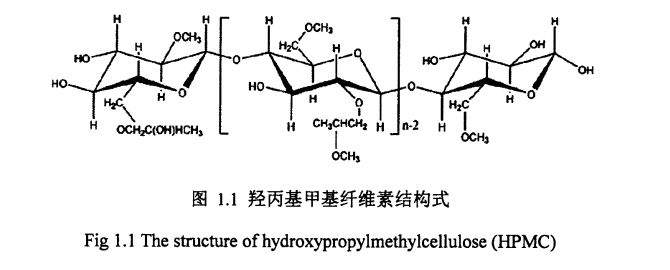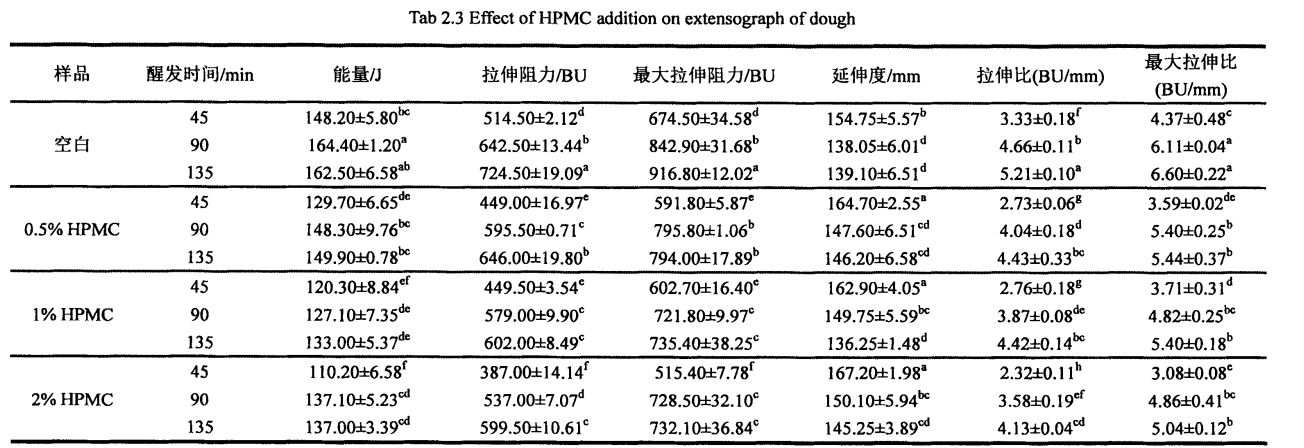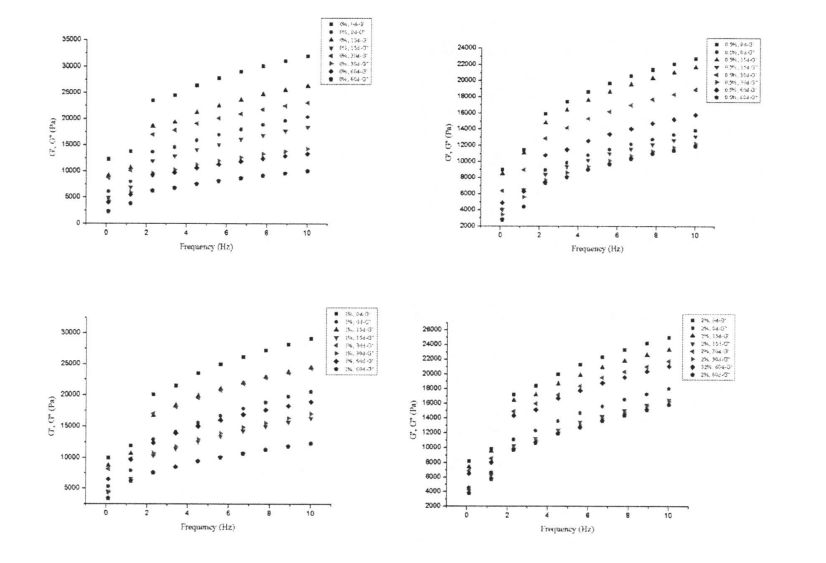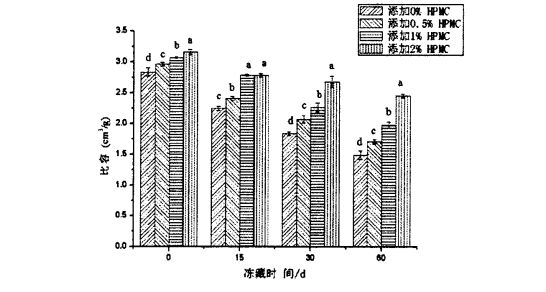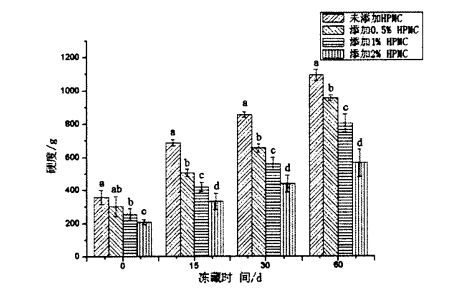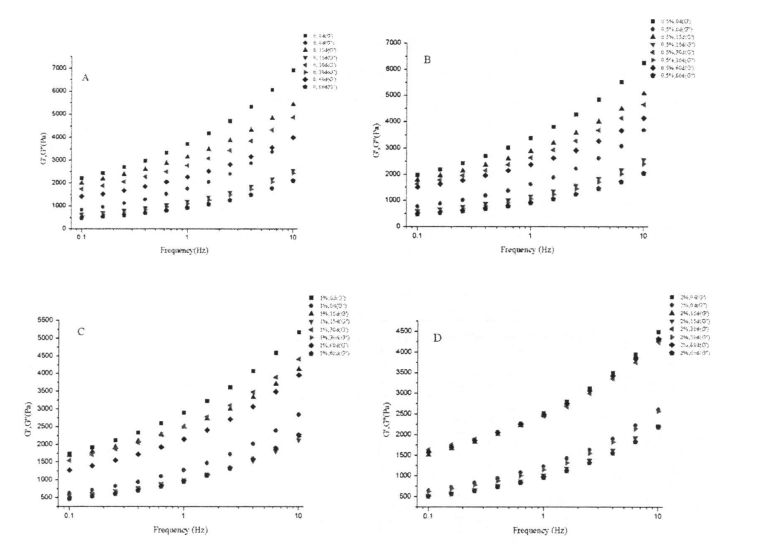1.1.7 Hydroxypropyl methyl cellulose (Hydroxypropyl methyl cellulose, I-IPMC) ………. 5
Chapter 2 Effects of HPMC addition on the processing properties of frozen dough and the quality of steamed bread………………………………………………………………………………………………... 8
2.3 Experimental results and discussion…………………………………………………………………… . 11
3.2.4 Experimental methods ....................................................................................................... 25
3.3.2 The effect of adding amount of HPMC and freezing storage time on the freezable moisture content (CFW) and thermal stability……………………………………………………………………. 30
3.3.3 Effects of HPMC addition amount and freezing storage time on free sulfhydryl content (C vessel) …………………………………………………………………………………………………………. . 34
4.1 Introduction .............................................................................................................................. . 44
4.2 Experimental materials and methods ................................................................................. 45
4.3 Analysis and discussion ........................................................................................................... 48
4.3.1 Content of basic components of wheat starch ……………………………………………………. 48
4.3.3 Effects of HPMC addition and freezing storage time on the shear viscosity of starch paste………………………………………………………………………………………………………………………………………. 52
4.3.6 Effects of I-IPMC addition amount and frozen storage time on the thermodynamic properties of starch ………………………………………………………………………………………………………. . 57
Chapter 5 Effects of HPMC addition on yeast survival rate and fermentation activity under frozen storage conditions………………………………………………………………………………………………. . 62
5.1Introduction .................................................................................................................................... 62
5.2 Materials and methods ............................................................................................................ 62
5.2.2 Experimental methods . । । . . …………………………………………………………………………. 63
5.3 Results and Discussion ............................................................................................................... 64
5.3.3 The effect of adding amount of HPMC and freezing time on the content of glutathione in dough……………………………………………………………………………………………………………66. "
5.4 Chapter Summary ........................................................................................................................ 67
6.1 Conclusion ................................................................................................................................. . 68
6.2 Outlook .......................................................................................................................................... 68
Figure 1.1 The structural formula of hydroxypropyl methylcellulose………………………. . 6
Figure 2.4 The effect of HPMC addition and freezing time on the elasticity of steamed bread………………………………………………………………………………………………………………………………. . 20
Figure 3.1 The effect of HPMC addition and freezing time on the rheological properties of wet gluten…………………………………………………………………………………………………………………………. 30
Figure 3.2 Effects of HPMC addition and freezing time on the thermodynamic properties of wheat gluten………………………………………………………………………………………………………………. . 34
Figure 3.3 Effects of HPMC addition and freezing time on free sulfhydryl content of wheat gluten……………………………………………………………………………………………………………………………... . 35
Figure 3.7 The effect of HPMC addition and freezing time on the microscopic gluten network structure…………………………………………………………………………………………………………... . 43
Figure 4.1 Starch gelatinization characteristic curve ............................................................... 51
Figure 4.2 Fluid thixotropy of starch paste ................................................................................. 52
Figure 4.3 Effects of adding amount of MC and freezing time on the viscoelasticity of starch paste……………………………………………………………………………………………………………………... . 57
Figure 4.5 Effects of HPMC addition and freezing storage time on the thermodynamic properties of starch…………………………………………………………………………………………………………. . 59
Figure 5.2 The effect of HPMC addition and freezing time on the yeast survival rate…………………………………………………………………………………………………………………………………... . 67
Figure 5.3 Microscopic observation of yeast (microscopic examination) …………………………………………………………………………………………………………………………. 68
Table 2.1 The basic ingredient content of wheat flour…………………………………………………. 11
Table 2.4 The effect of I-IPMC addition amount and freezing time on the freezable water content (CF work) of frozen dough………………………………………………………………………………………….17
Table 3.2 Effects of I-IPMC addition amount and freezing storage time on the phase transition enthalpy (Yi IV) and freezer water content (e chat) of wet gluten………………………. 31
Table 3.3 Effects of HPMC addition amount and freezing storage time on the peak temperature (product) of thermal denaturation of wheat gluten…………………………………………. 33
Table 3.6 Effects of I-IPMC addition and freezing storage time on the surface hydrophobicity of wheat gluten……………………………………………………………………………………………. 41
Table 4.3 Effects of I-IPMC addition and freezing time on the shear viscosity of wheat starch paste…………………………………………………………………………………………………………………………. 55
3)Research on dough preparation and steamed bread making technology. Research on the influence of steamed bread production process conditions on its quality and process optimization; Liu Changhong et al. (2009) ମଗ୍ କକ୍ଷଗୁଡ଼ିକ ପ୍ରକ୍ରିୟା ଯେପରିକି ଜଳ ବ୍ୟବସ୍ଥା, ଗୁପ୍ତ ମିଶ୍ରଣ ସମୟ, ଏବଂ ମଗୁଡ଼ ମକଦ୍ଦମୀର ଧଳା ରଙ୍ଗ ଉପରେ ଏହାର ପ୍ରଭାବ ରହିଛି | It has a significant impact on sensory evaluation. If the process conditions are not suitable, it will cause the product to turn blue, dark or yellow. The research results show that during the dough preparation process, the amount of water added reaches 45%, and the dough mixing time is 5 minutes, ~ When the pH value of the dough was 6.5 for 10 min, the whiteness value and sensory evaluation of the steamed buns measured by the whiteness meter were the best. When rolling the dough 15-20 times at the same time, the dough is flaky, smooth, elastic and shiny surface; when the rolling ratio is 3:1, the dough sheet is shiny, and the whiteness of the steamed bread increases [l to; Li, et a1. (2015) explored the production process of compound fermented dough and its application in steamed bread processing [13].
The emergence of frozen dough not only creates conditions for the industrialization, standardization, and chain production of fermented pasta products, it can effectively shorten processing time, improve production efficiency, and reduce production time and labor costs. Therefore, the aging phenomenon of the pasta food is effectively inhibited, and the effect of prolonging the shelf life of the product is achieved. ତେଣୁ, ୟୁରୋପ, ଆମେରିକା, ଜାପାନ ଏବଂ ଅନ୍ୟାନ୍ୟ ବିଶ୍ of ର ଅନ୍ୟ ଦେଶଗୁଡିକ, ଫ୍ରିଟି ରୁଟି (ରୁଟି), ଫ୍ରେଞ୍ଚ ମିଠା ରୁଟି (- ଷ୍ଟିକ୍), କୁକିଜ୍ ଏବଂ ଫ୍ରେଞ୍ଚ
II। Optimization of frozen dough production process, frozen storage conditions and formula. During the production of frozen dough, temperature control, proofing conditions, pre-freezing treatment, freezing rate, freezing conditions, moisture content, gluten protein content, and thawing methods will all affect the processing properties of frozen dough [37]. In general, higher freezing rates produce ice crystals that are smaller in size and more uniformly distributed, while lower freezing rates produce larger ice crystals that are not uniformly distributed. In addition, a lower freezing temperature even below the glass transition temperature (CTA) can effectively maintain its quality, but the cost is higher, and the actual production and cold chain transportation temperatures are usually small. In addition, the fluctuation of the freezing temperature will cause recrystallization, which will affect the quality of the dough.
III Using additives to improve the product quality of frozen dough. ଫ୍ରିଜ୍ ମଇଦାର ଉତ୍ପାଦର ଗୁଣକୁ ଉନ୍ନତ କରିବାକୁ ଅନେକ ଗର୍ଭଧାରଣର ମଇଦାରୁ ଅନେକ ଗବେଷଣା କାର୍ଯ୍ୟ କରି, ଉଦାହରଣ୍ୟୁର ନିମ୍ନ ଗଠନର ନିମ୍ନମାନ ଉପାଦାନଗୁଡ଼ିକର ସହଯୋଗୀତା ଉନ୍ନତ କରିଥାଏ, ଯୋଗଦାନର ବ୍ୟବହାର ହେଉଛି ଏକ ପ୍ରଭାବଶାଳୀ ଏବଂ ବ୍ୟାପକ ବ୍ୟବହାର ପଦ୍ଧତି | Mainly include, i) enzyme preparations, such as, transglutaminase, O [. Amylase; ii) emulsifiers, such as monoglyceride stearate, DATEM, SSL, CSL, DATEM, etc.; iii) antioxidants, ascorbic acid, etc.; iv) polysaccharide hydrocolloids, such as guar gum, yellow Originalgum, gum Arabic, konjac gum, sodium alginate, etc.; v) other functional substances, such as Xu, et a1. (2009) added Ice-structuring Proteins to wet gluten mass under freezing conditions, and studied its protective effect and mechanism on the structure and function of gluten protein [y71.
It is precisely because the relevant application research of HPMC in Chinese noodles is still relatively lacking. Therefore, the purpose of this experiment is to expand the application of HPMC to frozen dough, and to determine the improvement of frozen dough processing by HPMC through the evaluation of steamed bread quality. In addition, HPMC was added to the three main components of the dough (wheat protein, starch and yeast liquid), and the effect of HPMC on the structure and properties of wheat protein, starch and yeast was systematically studied. ଏବଂ ଏହାର ସମ୍ବନ୍ଧୀୟ ପର୍ବତାର ସହ ବ୍ୟାଖ୍ୟା କରିବାକୁ, ଖାଦ୍ୟ କ୍ଷେତ୍ରର ଗୁଣ ପାଇଁ HPMC ର ପ୍ରୟୋଗକୁ ବିସ୍ତାର କରିବା ଏବଂ ବାଷ୍ପଗତ ଉତ୍ପାଦନ ପାଇଁ ତତ୍ତ୍ୱିକ ସହାୟତା ପ୍ରଦାନ କରିବ |
ସାଧାରଣତ love କଥା କହିବା, ଫରେନ୍ମେଡ୍ ମଇଦା ଉତ୍ପାଦ ତିଆରି କରିବା ପାଇଁ ବ୍ୟବହୃତ ମଇଦା ରଚନା ମୁଖ୍ୟତ by ଜୋରୋଜିକ୍, ପ୍ରୋଟିନ୍ ପାଣି, ଅର୍ଗାନ, କ୍ରସ-ଲିଙ୍କ୍ ଏବଂ ପାରସ୍ପରିକ କ୍ରିୟାଗୁଡ଼ିକ ପରେ ଗଠିତ | A stable and complex material system with a special structure has been developed. Numerous studies have shown that the properties of the dough have a significant impact on the quality of the final product. Therefore, by optimizing the compounding to meet the specific product and it is a research direction to improve the dough formulation and technology of the quality of the product or food for use; on the other hand, improving or improving the properties of dough processing and preservation to ensure or improve the quality of the product is also an important research issue.
Powder meter. ଇ
Extensometer. ଇ
ନିର୍ମାତା
After the corresponding freezing time, the frozen dough was taken out, first equilibrated in a 4°C refrigerator for 4 h, and then placed at room temperature until the frozen dough was completely thawed. ମଇଦାକୁ ପ୍ରତି ଭାଗରେ ପ୍ରାୟ 70 ଟି ଗ୍ରାମରେ ବିଭକ୍ତ କର, ଏବଂ ତା'ପରେ ଏହାକୁ ଏକ ନିରନ୍ତର ତାପମାତ୍ରାରେ ଏବଂ ଆର୍ଦ୍ରତା ବାକ୍ସରେ ରଖ, ଏବଂ ଏହାକୁ 65% ର ଏକ ଆପେକ୍ଷିକ ଆଡାଦ୍ରତା | After proofing, steam for 20 min, and then cool for 1 h at room temperature to evaluate the quality of steamed bread.
As shown in Table 2.2, with the increase of HPMC addition, the water absorption of dough increased significantly, from 58.10% (without adding HPMC dough) to 60.60% (adding 2% HPMC dough). In addition, the addition of HPMC improved the dough stability time from 10.2 min (blank) to 12.2 min (added 2% HPMC). ତଥାପି, HPMC ଯୋଗର ବୃଦ୍ଧି ସହିତ, ଉଭୟ ମଇଳା ସୃଷ୍ଟି କରିବା ଯଥାକ୍ରମେ, ମଇଳା ଦୁର୍ବଳ ଡିଗ୍ରୀଗୁଡିକ ଯଥାକ୍ରମେ, 2.10 ମିନିଟ୍ ଏବଂ ଓଜନି ସମୟର ଓଜନ ବିଶିଷ୍ଟ 45.50% ଏବଂ 67.27% ଦ୍ by ାରା 28.50% ଏବଂ 67.27% ଦ୍ diver ାରା 28.50% ଏବଂ 67.27% ହ୍ରାସ ପାଇଛି |
Table 2.3 lists the effects of different amounts of HPMC (O, 0.5%, 1% and 2%) and different proofing 1'9 (45 min, 90 min and 135 min) on the dough tensile properties (energy, stretch resistance, maximum stretch resistance, elongation, stretch ratio and maximum stretch ratio). The experimental results show that the tensile properties of all dough samples increase with the extension of the proofing time except the elongation which decreases with the extension of the proofing time. ଶକ୍ତି ମୂଲ୍ୟ ପାଇଁ, 0 ରୁ 90 ମିନିଟରୁ, ଅବଶିଷ୍ଟ ମଇଳା ନମୁନାଗୁଡ଼ିକ 1% hpmc ଯୋଗ ବ୍ୟତୀତ ଧୀରେ ଧୀରେ ବୃଦ୍ଧି ପାଇଲା, ଏବଂ ସମସ୍ତ ମଗୁଣ ନମୁନାଗୁଡ଼ିକର ଶକ୍ତି ମୂଲ୍ୟ ଧୀରେ ଧୀରେ ବୃଦ୍ଧି ପାଇଲା | There were no significant changes. This shows that when the proofing time is 90 min, the network structure of the dough (cross-linking between molecular chains) is completely formed. Therefore, the proofing time is further extended, and there is no significant difference in the energy value. At the same time, this can also provide a reference for determining the proofing time of the dough. As the proofing time prolongs, more secondary bonds between molecular chains are formed and the molecular chains are more closely cross-linked, so the tensile resistance and the maximum tensile resistance increase gradually. At the same time, the deformation rate of molecular chains also decreased with the increase of secondary bonds between molecular chains and the tighter cross-linking of molecular chains, which led to the decrease of the elongation of the dough with the excessive extension of the proofing time. The increase in tensile resistance/maximum tensile resistance and the decrease in elongation resulted in an increase in tensile LL/maximum tensile ratio.

Hydroxypropyl methylcellulose (HPMC) is a kind of hydrophilic colloid, and its application research in frozen dough with Chinese-style pasta food (such as steamed bread) as the final product is still lacking. The main purpose of this study is to evaluate the effect of HPMC improvement by investigating the effect of HPMC addition on the processing properties of frozen dough and the quality of steamed bread, so as to provide some theoretical support for the application of HPMC in steamed bread and other Chinese-style flour products. The results show that HPMC can improve the farinaceous properties of the dough. When the addition amount of HPMC is 2%, the water absorption rate of the dough increases from 58.10% in the control group to 60.60%; 2 min increased to 12.2 min; at the same time, the dough formation time decreased from 2.1 min in the control group to 1.5 mill; the weakening degree decreased from 55 FU in the control group to 18 FU. In addition, HPMC also improved the tensile properties of the dough. With the increase in the amount of HPMC added, the elongation of the dough increased significantly; significantly reduced. ଏହା ସହିତ, ଫ୍ରିଜ୍ ଷ୍ଟୋରେଜ୍ ଅବଧି ସମୟରେ hpmc ଙ୍କ ଯୋଗକୁ ମଇଦାରେ ହ୍ରାସ କରିବାରେ ହ୍ରାସ ପାଇଲା, ମହୁ ମାଇକ୍ରୋମାଟାଇଜେସନ୍ ଦ୍ୱାରା ଘଟିଥିବା ମଇଦା ନେଟୱାର୍କ ଗଠନ ଏବଂ ଶବ୍ଦ ସଂରଚନାର ସ୍ଥିରତା ବୃଦ୍ଧି କରିବାରେ ଲାଗିଛି। The quality of the final product is guaranteed.
ନିର୍ମାତା
ଏକ ବେକରରେ 100 ଗ୍ରାମ ଗ୍ଲୁଟନ୍, ଏହାକୁ 5 ମିନିଟ୍ ପାଇଁ ଏକ ଗ୍ଲାସ୍ ବାଡି ଯୋଡନ୍ତୁ, ଏବଂ ଏହାକୁ ଏକ ସତେଜ ରଖିବାରେ ଏକ ଫ୍ରିଡ୍ରିଜରେଟର୍ କରନ୍ତୁ | ଶେଷରେ, ଏହାକୁ ଏକ ରେଫ୍ରିଜରେଟରରେ ଫ୍ରିଜ୍ କରନ୍ତୁ | ଶେଷରେ ଏହାକୁ ଫ୍ରିଜ୍ କରନ୍ତୁ | ଶେଷରେ ଏହାକୁ ଫ୍ରିଜ୍ କରନ୍ତୁ | ଶେଷରେ ଏହାକୁ ଫ୍ରିଜ୍ କରନ୍ତୁ | ଏକ ନିର୍ଦ୍ଦିଷ୍ଟ ସମୟ ପାଇଁ .18 ℃ (15 ଦିନ, 30 ଦିନ ଏବଂ 60 ଦିନ) ଫ୍ରିଜ୍ 0-ଦିନ ନମୁନା (j, 1% ଏବଂ 2% ଏବଂ 2% ଏବଂ 2% ଏବଂ 2% ଏବଂ 2% HPMC (W / W) କୁ ଅପରିବର୍ତ୍ତିତ ରଖେ | gluten dough samples with different HPMC additions.
When the corresponding freezing time is over, take out the frozen wet gluten mass and place it in a 4°C refrigerator to equilibrate for 8 hours. ତାପରେ, ନମୁନା ସଂପୂର୍ଣ୍ଣ ନହେବା ପର୍ଯ୍ୟନ୍ତ ଏକ ନମୁନା ବାହାର କରନ୍ତୁ ଏବଂ କୋଠରୀ ତାପମାତ୍ରାରେ ଏହାକୁ କୋଠରୀ ଉପରେ ରଖନ୍ତୁ (ଓଦା ଗ୍ଲୁଟେନ୍ ମାସ ଥୱେ ଶେଷରେ ଏହି ପଦ୍ଧତି ପରୀକ୍ଷଣର ଅଂଶ, 2.7.1 ଏବଂ 2.9) ପାଇଁ ପ୍ରଯୁଜ୍ୟ, 2.7.1 ଏବଂ 2.9) | ତରଳାଯାଇଥିବା ଓଦା ଗ୍ଲୁଟେନ୍ ମାସର କେନ୍ଦ୍ରୀୟ କ୍ଷେତ୍ରର ଏକ ନମୁନା (ପ୍ରାୟ 2 ଜି) ରିକୋଟରର ନମୁନା ବାହକ (ତଳ ପ୍ଲେଟ) ର ନମୁନା ବାହକ (ଦ୍ୱିପରିତ ପ୍ଲେଟ) କଟ୍ କଟି ଯାଇଥିଲା | Strain Sweep) to determine the Linear Viscoelasticity Region (LVR), the specific experimental parameters are set as follows - the fixture is a parallel plate with a diameter of 40 mill, the gap is set to 1000 mrn, and the temperature is set to 25 °C, the strain scanning range is 0.01%. 100%, the frequency is set to 1 Hz. Then, after changing the sample, let it stand for 10 minutes, and then perform dynamic
3 ଫଳାଫଳ ଏବଂ ଆଲୋଚନା
Note: Among them, A is the oscillating frequency scanning result of wet gluten without adding HPMC: B is the oscillating frequency scanning result of wet gluten adding 0.5% HPMC; C ହେଉଛି 1% H ppmc: d ଯୋଡିବା ପାଇଁ ଯଥା ଆଶ୍ଚର୍ଯ୍ୟଜନକ ଫ୍ରିକ୍ୱେନ୍ସି ସ୍କାନିଂ |
CFW ରେ ବୃଦ୍ଧି ହେଉଛି ମୁଖ୍ୟତ rery ପୁନରୁଦ୍ଧାର ପ୍ରକ୍ରିୟା ହେତୁ ଏବଂ ଗ୍ଲୁଟ୍ ପ୍ରୋଟିନ୍ ରୂପାନ୍ତର ହେତୁ, ଯାହା ଜଳର ସ୍ଥିତିକୁ ଫ୍ରିଜେବୁଲ୍ ଜଳକୁ ଫ୍ରିଜେବୁଲ୍ ଜଳ ପର୍ଯ୍ୟନ୍ତ ପରିବର୍ତ୍ତନ କରେ | This change in moisture state allows ice crystals to be trapped in the interstices of the network structure, the network structure (pores) gradually become larger, which in turn leads to greater squeezing and destruction of the walls of the pores. However, the significant difference of 0w between the sample with a certain content of HPMC and the blank sample shows that HPMC can keep the water state relatively stable during the freezing process, thereby reducing the damage of ice crystals to the gluten network structure, and even inhibiting the quality of the product. deterioration.

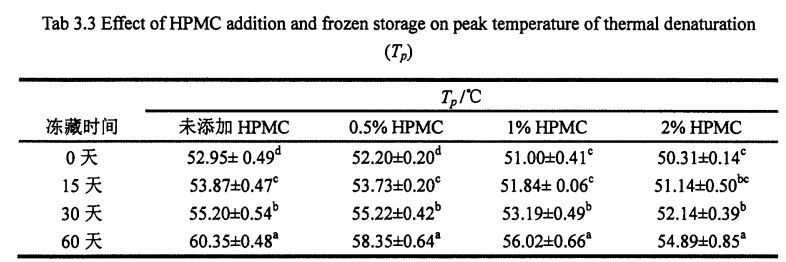
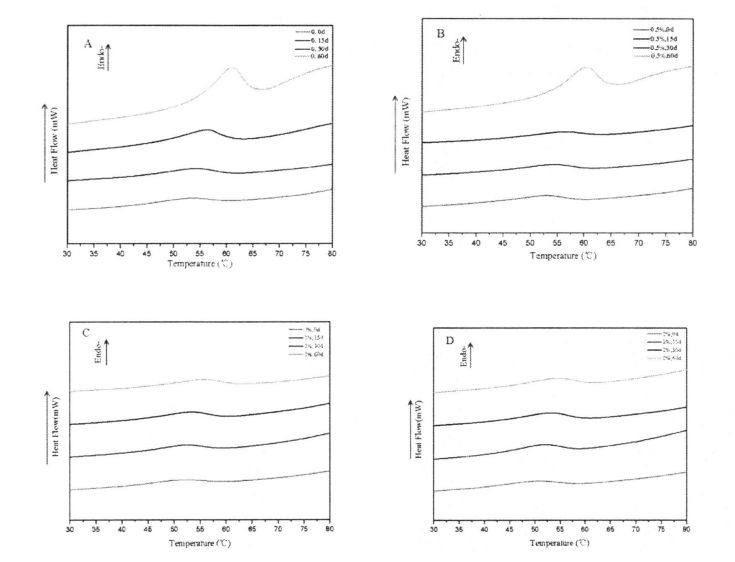
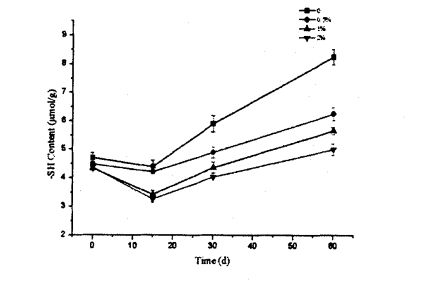
ଉପରୋକ୍ତ ପରି ଗ୍ଲୁଟେନ୍ ଯୋଗର ବିଷୟବସ୍ତୁ ଉପରେ FPMC ଯୋଗ ଏବଂ ଫ୍ରି-ଶିଙ୍କ ଅଧୀନରେ ଥିବା FPMC ଯୋଗର ଅନ୍ତରାପୃଷ୍ଠ ଏବଂ ଫ୍ରି-ଶିଙ୍କ ଅଧୀନରେ ଥିବା ପ୍ରଭାବ ଏବଂ ଗ୍ଲୁଟେନ୍ ନେଟୱାର୍କର ଆନ୍ତ prosts ଳୀରେ ବଣ୍ଟନ କରିପାରିବ | Therefore, with the prolongation of freezing time, the ice crystals become larger, which squeezes the gluten protein structure more seriously, and leads to the breakage of some intermolecular and intramolecular disulfide bonds, which increases the content of free sulfhydryl groups. On the other hand, the experimental results show that HPMC can protect the disulfide bond from the extrusion damage of ice crystals, thereby inhibiting the depolymerization process of gluten protein. 3.3.4 Effects of HPMC addition amount and freezing storage time on transverse relaxation time (T2) of wet gluten mass The distribution of Transverse Relaxation Time (T2) can reflect the model and dynamic process of water migration in food materials [6]. Figure 3.4 shows the distribution of wet gluten mass at 0 and 60 days with different HPMC additions, including 4 main distribution intervals, namely 0.1.1 ms (T21), 1.10 ms (T22), 10.100 ms (dead;) and 1 00-1 000 ms (T24). Bosmans et al. (2012) found a similar distribution of wet gluten mass [1261], and they suggested that protons with relaxation times below 10 ms could be classified as rapidly relaxing protons, which are mainly derived from poor mobility the bound water, therefore, may characterize the relaxation time distribution of bound water bound to a small amount of starch, while Dang may characterize the relaxation time distribution of bound water bound to gluten protein. In addition, Kontogiorgos (2007) - t11¨, the "strands" of the gluten protein network structure are composed of several layers (Sheets) about 5 nm apart, and the water contained in these layers is limited water (or Bulk water, phase water), the mobility of this water is between the mobility of bound water and free water. And T23 can be attributed to the relaxation time distribution of restricted water. The T24 distribution (>100 ms) has a long relaxation time, so it characterizes free water with strong mobility. This water exists in the pores of the network structure, and there is only a weak capillary force with the gluten protein system.
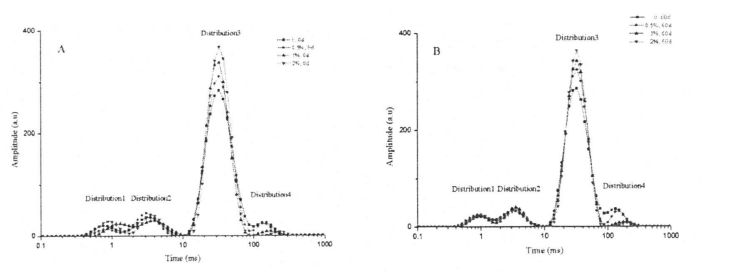
ତଥାପି, T23 ଓଦା ଗ୍ଲାଉଟେନ ମାସର ଉଚ୍ଚତା ଏବଂ ବିଭିନ୍ନ ପ୍ରକାରର ପାର୍ଥକ୍ୟ ଘଟିଥିଲା ଯାହା ଫ୍ରିଜ୍ ଏବଂ ଯୋଗ ବୃଦ୍ଧି ନଥିଲା, ଏବଂ ୱେବସାଇଟ୍ ବଣ୍ଟନ ବୃଦ୍ଧି ସହିତ, T23 ବଣ୍ଟନ ବୃଦ୍ଧି (F23 ବଣ୍ଟନ ବୃଦ୍ଧି (ଚିତ୍ରଭୁକ୍ତ | ଏହି ପରିବର୍ତ୍ତନ ଦେଖାଏ ଯେ hpmc ସୀମିତ ଜଳର ଆପେକ୍ଷିକ ବିଷୟବସ୍ତୁକୁ ଗୁରୁତର ଭାବରେ ବୃଦ୍ଧି କରିପାରିବ, ଏବଂ ଏକ ନିର୍ଦ୍ଦିଷ୍ଟ ପରିସର ମଧ୍ୟରେ ଅତିରିକ୍ତ ପରିମାଣରେ ଏହା ସକରାତ୍ମକ ଭାବରେ ସମ୍ବନ୍ଧିତ | In addition, with the extension of freezing storage time, the height and area of T23 distribution of the wet gluten mass with the same HPMC content decreased to varying degrees. Therefore, compared with bound water, limited water showed a certain effect on freezing storage. Sensitivity. This trend suggests that the interaction between the gluten protein matrix and the confined water becomes weaker. This may be because more hydrophobic groups are exposed during freezing, which is consistent with the thermal denaturation peak temperature measurements. In particular, the height and area of the T23 distribution for the wet gluten mass with 2% HPMC addition did not show a significant difference. This indicates that HPMC can limit the migration and redistribution of water, and can inhibit the transformation of the water state from the restricted state to the free state during the freezing process.

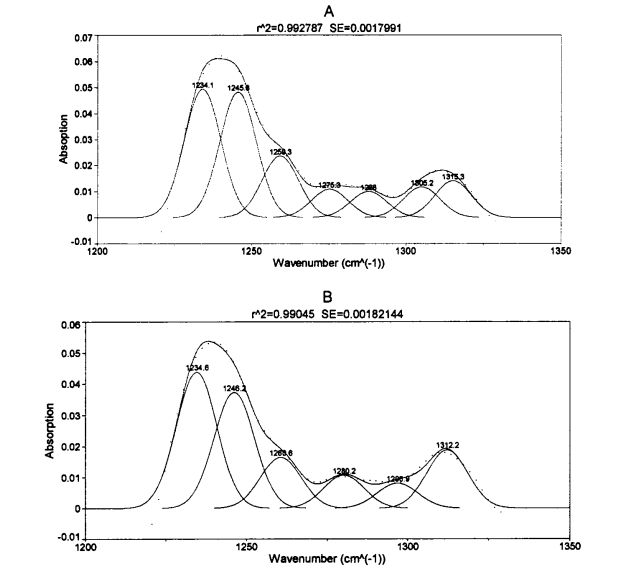
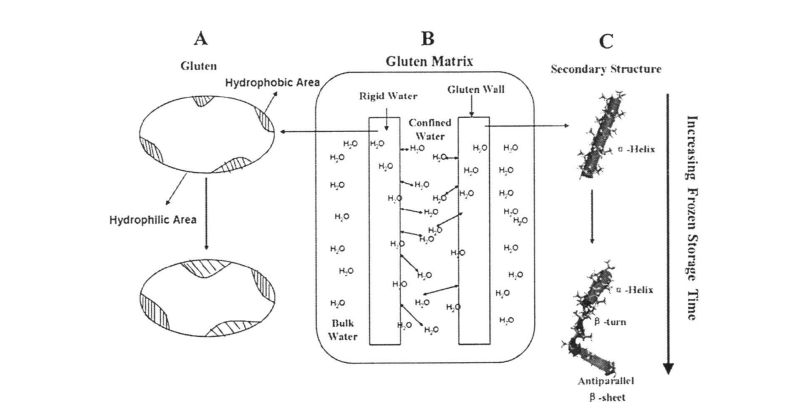
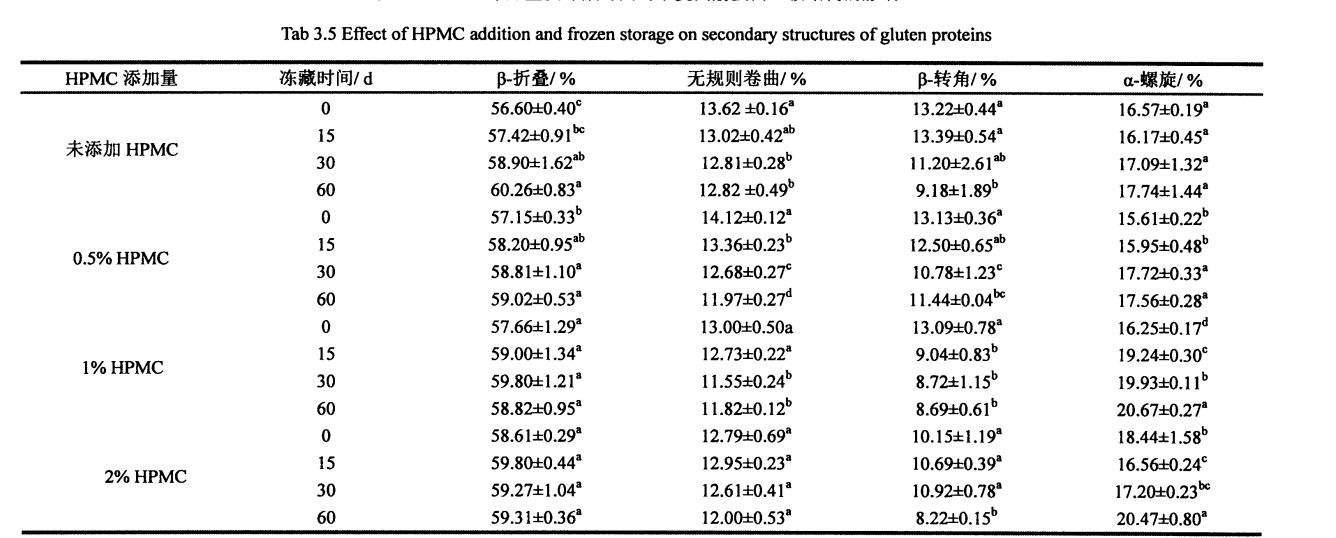

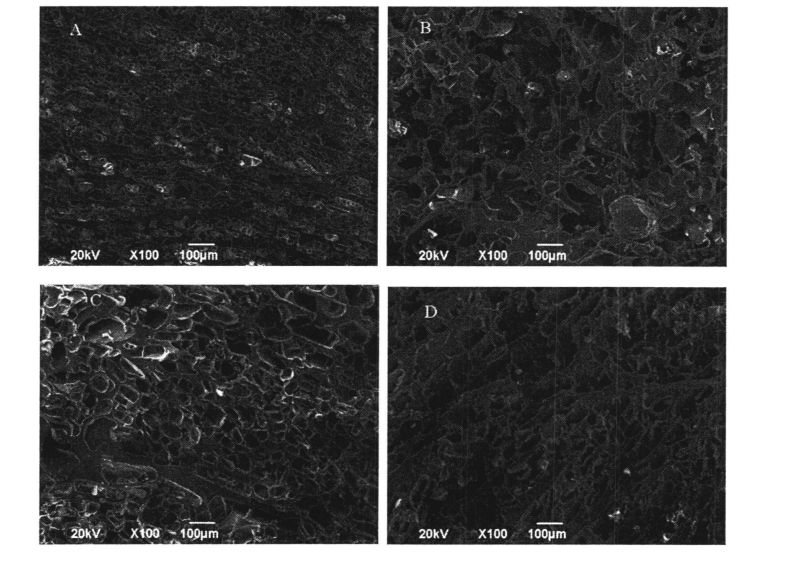
This experiment investigated the rheology of wet gluten dough and gluten protein by adding HPMC with different contents (0%, 0.5%, 1% and 2%) during freezing storage (0, 15, 30 and 60 days). properties, thermodynamic properties, and effects of physicochemical properties. ଅଧ୍ୟୟନଟି ଜାଣିଲା ଯେ ଫ୍ରିଜିଂ ଷ୍ଟୋରେଜ୍ ପ୍ରକ୍ରିୟା ସମୟରେ ଜଳ ସ୍ଥଳର ପରିବର୍ତ୍ତନ ଏବଂ ପୁନ istr ବଣ୍ଟନ ଯଥେଷ୍ଟ ବ extald ପକ୍ଷୀ ଦେଲା, ଆଇଟି ସ୍ଫଟିକର ଗଠନ ଏବଂ ବୃଦ୍ଧି ହେତୁ ଗ୍ଲାଇଟେର ପ୍ରକ୍ରିୟାକରଣ ଗୁଣକୁ ଅଲଗା କରିଦେଇଛି | Deterioration of product quality. ଫ୍ରିକ୍ୱେନ୍ସି ସ୍କାନିଂର ଫଳାଫଳ ପ୍ରଦର୍ଶିତ ହୋଇଛି ଯେ HPMC ଯୋଗ ନକରି ଓଦା ଷ୍ଟିଟିକ୍ ମଡ୍ୟୁଲସ୍ ଏବଂ ଭିଜୁଆଲ୍ ମଡ୍ୟୁଲସ୍ ଫ୍ରିଜ୍ ଷ୍ଟୋରେଜ୍ ପ୍ରକ୍ରିୟା ସମୟରେ ଯଥେଷ୍ଟ ସମୟ ହ୍ରାସ କରିଥିଲା ଯେ ଏହାର ମାଇକ୍ରୋଷ୍ଟ୍ରୁସ୍ର୍ୟୁଟି ନଷ୍ଟ ହୋଇଯାଇଛି | The content of free sulfhydryl group was significantly increased, and its hydrophobic group was more exposed, which made the thermal denaturation temperature and surface hydrophobicity of gluten protein significantly increased. However, the experimental results show that the addition of I-IPMC can effectively inhibit the changes in the structure and properties of wet gluten mass and gluten protein during freezing storage, and within a certain range, this inhibitory effect is positively correlated with the addition of HPMC. This is because HPMC can reduce the mobility of water and limit the increase of the freezable water content, thereby inhibiting the recrystallization phenomenon and keeping the gluten network structure and the spatial conformation of the protein relatively stable. This shows that the addition of HPMC can effectively maintain the integrity of the frozen dough structure, thereby ensuring product quality.
In general, starch gelatinization is affected by the source and type of starch, the relative content of amylose and amylopectin in starch, whether starch is modified and the method of modification, addition of other exogenous substances, and dispersion conditions (such as The influence of salt ion species and concentration, pH value, temperature, moisture content, etc.) [142-150]. ତେଣୁ, ଷ୍ଟାରଚର ଗଠନ (ସ sursterର ଼ ମର୍ଫୋଲୁଲୋଲୋଜି, ସ୍ follows ଶଳର ସଂରଚନା, ଇତ୍ୟାଦି) ପରିବର୍ତ୍ତନ ହୁଏ, ତେବେ ଉଠିବା ପାଇଁ ଇତ୍ୟାଦି ଇତ୍ୟାଦି |
ଏହି ପରୀକ୍ଷଣରେ, ବିଭିନ୍ନ HPMC ବିଷୟବସ୍ତୁ (0, 0.5%, 1%, 2%) (0, 15, 30, 60, 60 ଦିନ ଯୋଗାଇ ଅଧ୍ୟୟନ କରି HPMC ଯୋଡିଛି | on starch structure and its gelatinization influence of nature.
ନିର୍ମାତା
Draw 1.5 mL of sample solution and add it to the center of the rheometer sample stage, measure the gelatinization properties of the sample according to the above program parameters, and obtain the time (min) as the abscissa, the viscosity (Pa s) and the temperature (°C) as the starch gelatinization curve of the ordinate. GB / t 14490.2008.2008 [158] ଅନୁଯାୟୀ, ଅନୁରୂପ ଜାଲଟିନାଇଜେସନ୍ ଚରିତ୍ରିକ ସୂଚକ-ଜେଲାଟିନାଇଜେସନ୍ ଶିଖର ( Value, BV) and regeneration value (Setback Value, SV), wherein, decay value = peak viscosity - minimum viscosity; setback value = final viscosity - minimum viscosity. Each sample was repeated three times.





However, with the prolongation of freezing storage time, the values of K and n increased to different degrees, among which the value of K increased from 78.240 ± 1.661 Pa·sn (unadded, 0 days) to 95.570 ± 1, respectively. 2.421 Pa·sn (no addition, 60 days), increased from 65.683±1.035 Pa ·S n (addition of O. 5% HPMC, 0 days) to 51.384±1.350 Pa ·S n (Add to 0.5% HPMC, 60 days), increased from 43.122±1.047 Pa ·sn (adding 1% HPMC, 0 days) to 56.538±1.378 Pa ·sn (adding 1% HPMC, 60 days) ), and increased from 13.926 ± 0.330 Pa ·sn (adding 2% HPMC, 0 days) to 16.064 ± 0.465 Pa ·sn (adding 2% HPMC, 60 days); 0.277 ± 0.011 (without adding HPMC, 0 days) rose to O. 334±0.014 (no addition, 60 days), increased from 0.310±0.009 (0.5% HPMC added, 0 day) to 0.336±0.014 (0.5% HPMC added, 60 days), from 0.323 ± 0.013 (add 1% HPMC, 0 days) to 0.340 ± 0.013 (add 1% HPMC, 60 days), and from 0.431 ± 0.013 (add 1% HPMC, 60 days) 2% HPMC, 0 days) to 0.404+0.020 (add 2% HPMC, 60 days). By comparison, it can be found that with the increase of the addition amount of HPMC, the change rate of K and Knife value decreases successively, which shows that the addition of HPMC can make the starch paste stable under the action of shearing force, which is consistent with the measurement results of starch gelatinization characteristics. ସ୍ଥିର

The starch gelatinization process is accompanied by the disintegration of starch granules, the disappearance of the crystalline region, and the hydrogen bonding between starch chains and moisture, the starch gelatinized to form a heat-induced (Heat. induced) gel with a certain gel strength. As shown in Figure 4.3, for starch without frozen storage, with the increase of HPMC addition, the G' of starch decreased significantly, while G" had no significant difference, and tan 6 increased (Liquid. 1ike), which shows that during the gelatinization process, HPMC interacts with starch, and due to the water retention of HPMC, the addition of HPMC reduces the water loss of starch during the gelatinization process. At the same time, Chaisawang & Suphantharika (2005) found that, adding guar gum and xanthan gum to tapioca starch, the G' of the starch paste also decreased [170]. In addition, with the extension of the freezing storage time, the G' of starch gelatinized decreased to different degrees. This is mainly because during the frozen storage process of starch, the amylose in the amorphous region of starch granules is separated to form damaged starch (Damaged Starch), which reduces the degree of intermolecular cross-linking after starch gelatinization and the degree of cross-linking after cross-linking. ସ୍ଥିରତା ଏବଂ କମ୍ପାକ୍ଟନମେଣ୍ଟ, ଏବଂ ଆଇସ କ୍ରସଲ୍ସର ଶାରୀରିକ ସ୍ତରର "ମାଇକେଲ୍ସ" ର ବ୍ୟବସ୍ଥା କରେ, କିନ୍ତୁ ଏକ ସମୟରେ, ମେଲିକ୍ୟୁ ଆକ୍ସିନେସନ୍ ର ଏକ କମ୍ପାକ୍ଟ ଏବଂ ୱାଲ୍କରାଇଜେସନ୍, ନିମ୍ନମାନର ସମ୍ପାଦନା ଏବଂ ଜଳର ପର୍ଯ୍ୟାପ୍ତ ମିଶ୍ରଣକୁ ନେଇ ଗଠିତ | chain (molecular chain mobility), and finally caused the gel strength of starch to decline. However, with the increase of HPMC addition, the decreasing trend of G' was suppressed, and this effect was positively correlated with the addition of HPMC. ଏହା ସୂଚିତ କରିଛି ଯେ HPMC ର ଯୋଗକୁ ଫ୍ରିଜର୍ ଷ୍ଟୋରେଜ୍ ସ୍ଥିତିରେ ଷ୍ଟାର୍ଫେଟର ପ୍ରଭାବକୁ ପ୍ରଭାବଶାଳୀ ଭାବରେ ନିୟୋଜିତ କରିପାରେ |
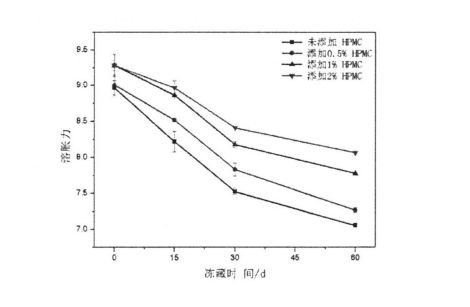
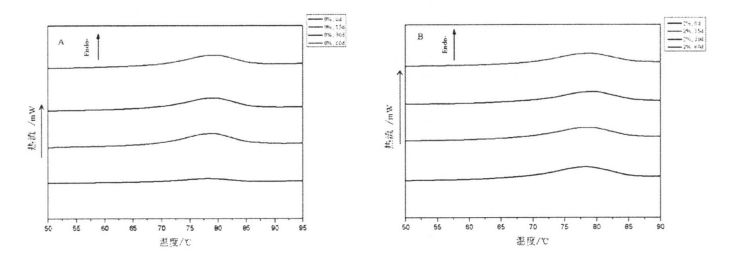
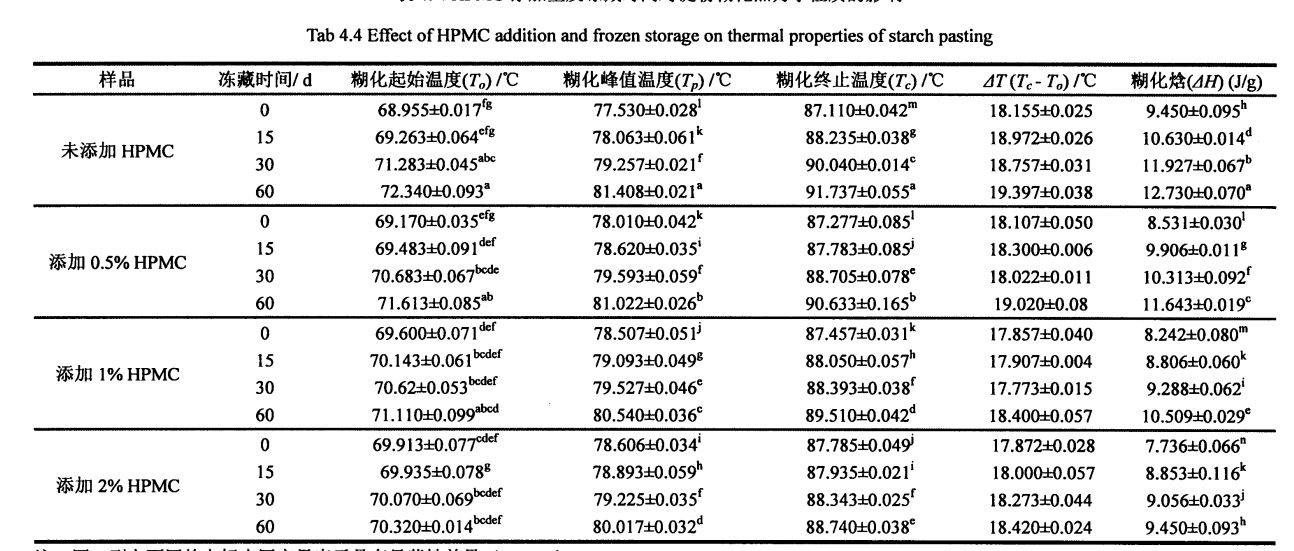
X. X-ray diffraction (XRD) is obtained by X. X-ray diffraction is a research method that analyzes the diffraction spectrum to obtain information such as the composition of the material, the structure or morphology of the atoms or molecules in the material. କାରଣ ଷ୍ଟାର୍କ ଗ୍ରାନୁଲ୍ସରେ ଏକ ସାଧାରଣ ସ୍ଫଟିକ୍ ସୃଷ୍ଟିକର୍ତ୍ତା ଅଛନ୍ତି, XRD ପ୍ରାୟତ syp ଷ୍ଟାର୍ ସ୍ଫଟିକ୍ ର ସ୍ଫଟିକ୍ ସ୍ଫଟିକ୍ ଏବଂ ଆପେଥାଲ୍ର ଆପେଷ୍ଟ୍ରନ୍ର ଆପେଥାଲ୍ର ସ୍ଫଟାନ୍କ୍ରାଞ୍ଜକୁ ବିଶ୍ଳେଷଣ କରିଥାଏ |
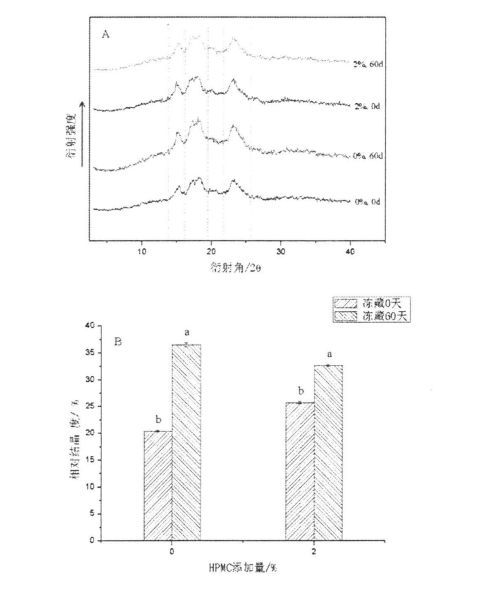
ମହୁ୍ରେ ଷ୍ଟାର୍କ ସବୁଠାରୁ ପ୍ରଚୁର ଶୁଷ୍କତା ଗୁରୁତ୍ୱପୂର୍ଣ୍ଣ, ଯାହା ଗେଲିନାଇଜେସନ୍ ପରେ, ଅନନ୍ୟ ଗୁଣଗୁଡିକ ଯୋଗ କରେ (ନିର୍ଦ୍ଦିଷ୍ଟ ଭଲ୍ୟୁମ୍, ଟେକ୍ସଚର୍, ଇତ୍ୟାଦି ସହିତ | ଯେହେତୁ ଷ୍ଟାର୍ ସଂରଚାର ପରିବର୍ତ୍ତନ ଏହାର ଗେଲିନାଇଜେସନ୍ ବ characterist ାମଣାକୁ ପ୍ରଭାବିତ କରିବ, ଯାହା ଏହି ପରୀକ୍ଷଣର ବିଭିନ୍ନ ଉତ୍ପାଦର ବିଭିନ୍ନ ବିଷୟବସ୍ତୁ ସହିତ ଷ୍ଟାର୍କର ବିଭିନ୍ନ ବିଷୟବସ୍ତୁ ସହିତ ଷ୍ଟାର୍ ନ ସସପେନ୍ସନ୍ ଏବଂ ବନ୍ୟର ଫଳାଫଳ ଉପରେ ନିର୍ଭର କରିପାରେ | Changes in rheological properties, thermodynamic properties and crystal structure were used to evaluate the protective effect of HPMC addition on starch granule structure and related properties. The experimental results showed that after 60 days of frozen storage, the starch gelatinization characteristics (peak viscosity, minimum viscosity, final viscosity, decay value and retrogradation value) all increased due to the significant increase in the relative crystallinity of starch and the increase in the content of damaged starch. The gelatinization enthalpy increased, while the gel strength of starch paste decreased significantly; however, especially the starch suspension added with 2% HPMC, the relative crystallinity increase and starch damage degree after freezing were lower than those in the control group Therefore, the addition of HPMC reduces the degree of changes in gelatinization characteristics, gelatinization enthalpy, and gel strength, which indicates that the addition of HPMC keeps the starch structure and its gelatinization properties relatively stable.
ନିର୍ମାତା
The proofing height of dough is often affected by the combined effect of yeast fermentation gas production activity and dough network structure strength. Among them, yeast fermentation activity will directly affect its ability to ferment and produce gas, and the amount of yeast gas production determines the quality of fermented flour products, including specific volume and texture. ଖରର ସ୍ଥାନାନ୍ତର କାର୍ଯ୍ୟକଳାପ ମୁଖ୍ୟତ ବାହ୍ୟ କାରଣ ଏବଂ ନାଇବୋଲୋଜ ଉତ୍ସ, ତାପମାତ୍ରା ସିଷ୍ଟମର କାର୍ଯ୍ୟକଳାପ (ଅଭିବୃଦ୍ଧି ଚକ୍ର, ଅଳ୍ପ କାରଣ, ଇତ୍ୟାଦି, କାର୍ଯ୍ୟକଳାପ କିମ୍ବା ଅଭିବୃଦ୍ଧି ଚକ୍ର, କାର୍ଯ୍ୟକଳାପ |

In the case of frozen storage, since the frozen water in the dough system is converted into ice crystals, the osmotic pressure outside the yeast cells is increased, so that the protoplasts and cell structures of the yeast are under a certain degree of stress. ଯେତେବେଳେ ତାପମାତ୍ରା ହ୍ରାସ ହୁଏ କିମ୍ବା କମ୍ ତାପମାତ୍ରାରେ ଚାଲିଥାଏ, ଅଳ୍ପ ପରିମାଣର ଆଇସ୍ ସ୍ଫଟିକମାନେ, ଖମୀରର ଗଠନ, ଯେପରିକି ସେଲ୍ ଫ୍ଲୁଇଡର ଉତ୍ପାଦନ - ଗ୍ଲୁଫିନ୍ କିମ୍ବା ମୃତ୍ୟୁ ସମ୍ବନ୍ଧୀୟ କାରଣ; at the same time, the yeast Under environmental stress, its own metabolic activity will be reduced, and some spores will be produced, which will reduce the fermentation gas production activity of yeast.
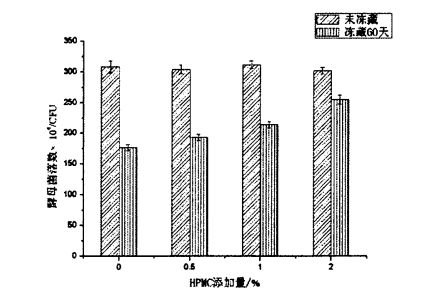
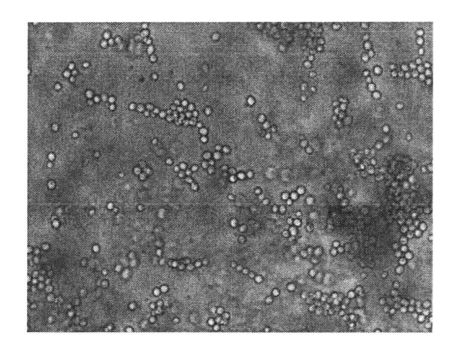
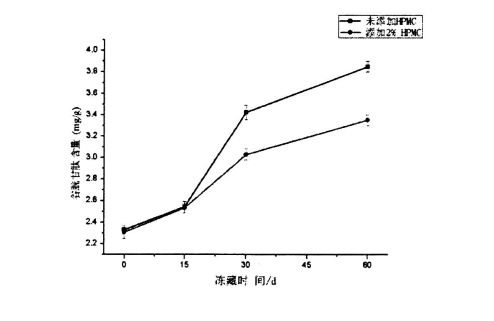
ପୋଷ୍ଟ ସମୟ: OCT-08-2022 |







